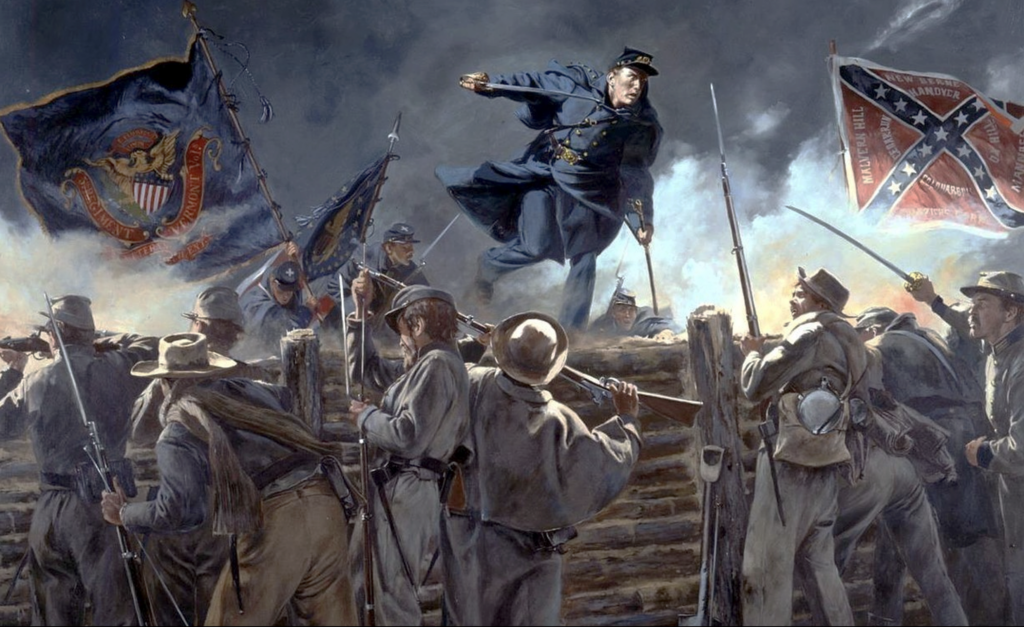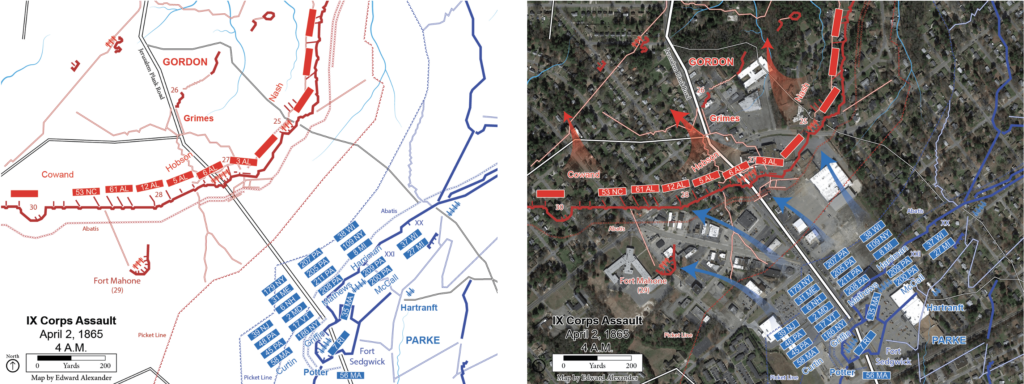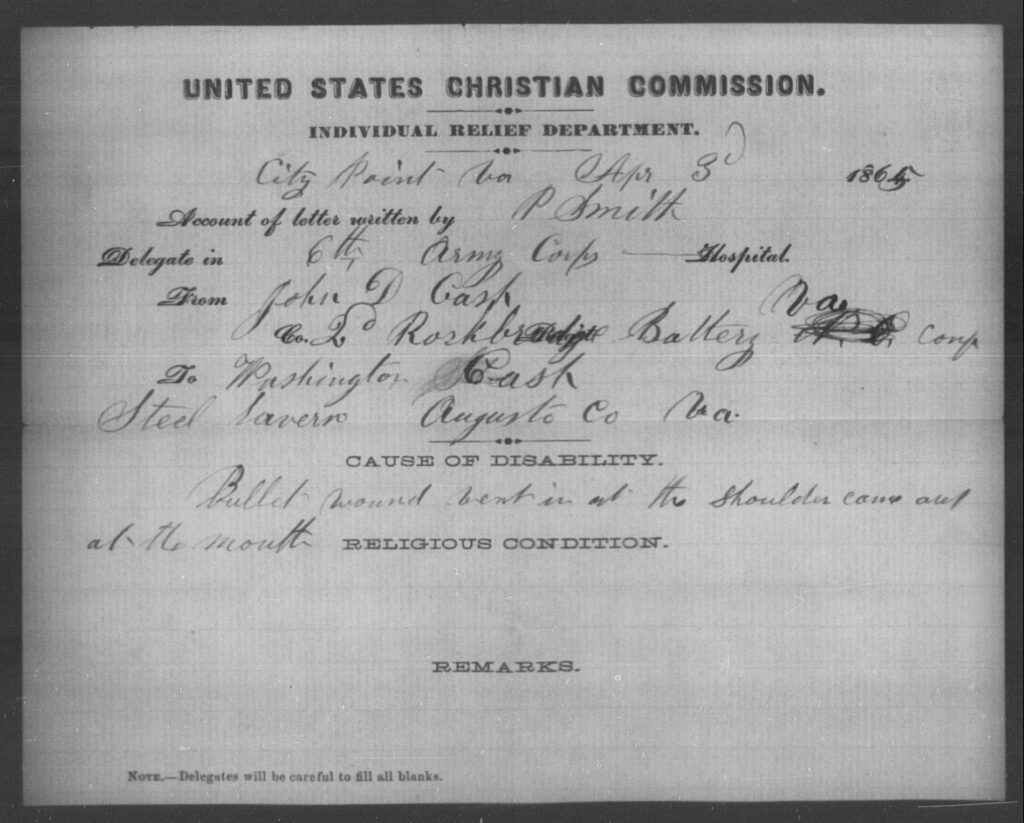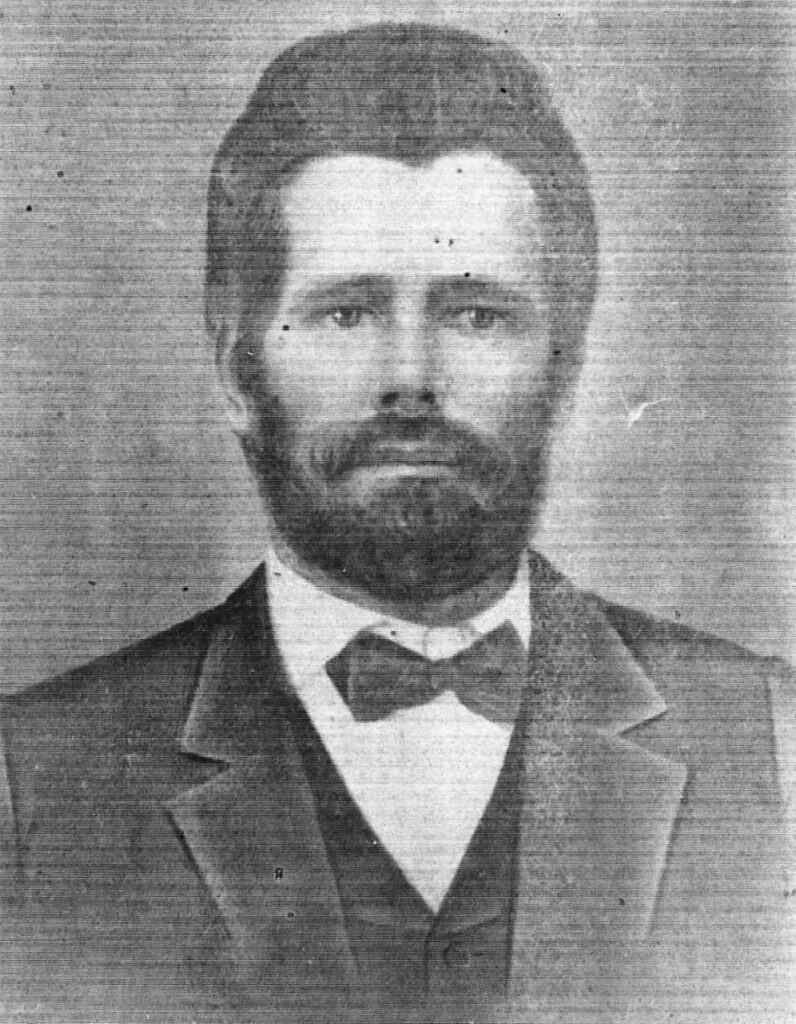Table of Contents
In the pre-dawn hours of April 2, 1865, the Union Army’s Fifth Vermont Infantry Regiment penetrated a section of Confederate earthworks near Petersburg, Virginia. Captain Charles Gould, the first Union soldier to mount the enemy’s works, “received a serious bayonet wound in the face, was struck several times with clubbed muskets, but bravely stood his ground, and with his sword killed the man who bayoneted him.”[1] Waves of Union troops also breached this line of rebel trenches and quickly overwhelmed their graycoat occupants. Horrific hand-to-hand mêlées ensured before the surviving Confederates retreated.

The successful breakthrough spearheaded by the Fifth Vermont upended 292 days of grueling trench warfare at Petersburg. Moreover, this action quickly galvanized Lieutenant General Ulysses S. Grant’s forces surrounding the besieged city. Several miles to the east of the initial breakthrough, Union forces – braving a hail of shot and shell – also punched through a stretch of Confederate earthworks and subsequently seized a line of gunpits near Fort Mahone.
Union Army Captain David Ritchie, Battery C commander of the First New York Light Artillery at Fort Sedgwick, recounted this surge of momentum in his after-action report. “I received an order…to take my cannoneers into the rebel works, which had then just been captured, and man such rebel guns I might find there. I immediately marched my four detachments of cannoneers at double-quick…across the plain directly up the Jerusalem road to the rebel fort…which was numbered by the enemy, Battery 27. I found in this work five 12-pounder rebel guns … There were between 200 and 300 rounds of ammunition in the fort, all of which I used on the enemy’s batteries.”[2]

With the Confederate’s frontline breached and their cannons turned against them, their reserve line of artillerists attempted to quell subsequent Yankee advancements. Equipped with three 24-pounder howitzers and one 8-inch howitzer, the Confederate’s Second Rockbridge Artillery commenced firing from their battery gunpit dubbed Fort Virginia. “This battery,” Captain Ritchie described, “was not more than 500 yards distant, and annoyed us severely with grape [shot], during the early part of the day.”[3] Among those Rockbridge cannoneers was Private John Washington Cash, one month shy of his twentieth birthday. Born in 1845 near the unincorporated communities of Vesuvius and Steeles Tavern, the Shenandoah Valley native had fought with the Confederate Army since the summer of 1863, most notably at the Battle of Gettysburg and the Overland Campaign.
While Cash did not keep a journal or diary throughout his soldiering, the fates of other Rockbridge gunners offer glimpses of the chaotic atmosphere that befell his fellow artillerists the morning of April 2, 1865. Private John Drawbond was severely wounded “while loading a cannon. In the excitement of battle, a man fired the cannon while [Drawbond’s] arm was in the muzzle.”[4] Meanwhile, Sergeant James Paxton “fell back to man a Maryland battery. There he lost his life, a musket ball hitting him in the head.”[5] Like the fate of many Confederate troops, the Rockbridge cannoneers at Fort Virginia were eventually overrun by Union troops.
Among the Second Rockbridge Artillery, four men – including the battery commander – were killed in action, five were wounded, and twenty-three were captured.[6] “The conduct of officers and men was worthy of all praise,” chronicled Confederate Brigadier General William Pendleton, the Army of Northern Virginia’s Chief of Artillery. “[They] fought until literally crushed by numbers…”[7] John Cash was among the Rockbridge cannoneers wounded and captured. On April 3, 1865, the United States Christian Commission dispatched a letter to Cash’s father to inform him of his son’s battlefield injuries: “Bullet wound went in at the shoulder [and] came out at the mouth”[8]

On April 5, 1865, Cash began his recuperation in Ward G of the Armory Square Hospital in Washington, D.C. There, further details of John’s maxillofacial trauma emerge from a report of wounded patients admitted to the ward. “Gunshot wound. Ball entered over the spine of the scapula, passed upwards, inward, and forward under the roof of the tongue and emerged a little to the right of the symphysis of lower jaw, fracturing the bone.”[9] It was also noted that John was struck by a Minié ball, a common munition for muzzle-loaded rifled muskets. On May 18, 1865, John was transferred to the nearby Lincoln General Hospital where, on June 12, 1865, he swore and signed an Oath of Allegiance to the United States.[10]

While the exact nature of John’s treatment is unknown, the Medical and Surgical History of the War of the Rebellion chronicled the prevailing care offered to soldiers who incurred gunshot wounds to the lower jaw. “In the Union armies, softened binders’ board, secured by a four-tailed bandage, was the ordinary dressing … In the base hospitals, complex apparatus of leather, gutta percha, papier maché were employed, according to the prevailing fashion of the selection of country in which the hospital was situated … Frequent detergent collutories, liquid food, and an antiphlogistic regiment were regarded as essential in the treatment.”[11]
Given the severity of his injuries, Cash likely underwent some form of reparative facial treatment. Unlike contemporary plastic surgeries (which use organic polymers), rudimentary attempts of facial reconstruction in the Civil War era sutured the patient’s skin and soft tissue surrounding the area of the injury (often without the relief of anaesthetics).[12] Severe tissue loss and the potential of infection and disease to the patient’s osseous structures undoubtedly stymied many well-intended attempts. Combined, these factors may explain why Army Medical Museum surgeon and Medical and Surgical History contributor Dr. George Otis held a rather dim outlook of these reparative surgeries. “The occasions on which autoplastic operations are likely to be employed advantageously are few in number.”[13]
On July 12, 1865, Cash was released from Lincoln General Hospital. He spent his remaining years not far from his Shenandoah Valley stomping grounds. Cash died in 1895, aged fifty.

About the Author:
Kyle Nappi is the great-great-great-grandnephew of John Washington Cash. An alumnus of The Ohio State University, Kyle serves as a national security policy specialist in the Washington, D.C. metropolitan area. He is also an independent researcher and writer of military history (chiefly the World Wars), having interviewed ~4,500 elder military combatants across nearly two-dozen countries.
Of note, John Cash’s younger brother William also served in the Second Rockbridge Artillery until he was wounded in the Battle of Fredericksburg. You can learn more about William’s battlefield injury in this April 2021 article with the National Museum of Civil War Medicine.
Endnotes:
[1] Office of the Adjutant General of the Army, American Decorations: A List of Awards of the Congressional Medal of Honor, the Distinguished-Service Cross, and the Distinguished-Service Medal, (Washington, D.C.: Government Printing Office, 1927), 39.
[2] U.S. Department of War, The War of the Rebellion: A Compilation of the Official Records of the Union and Confederate Armies, Series 1, Volume 46, Part 1, Section 2 (Washington, D.C.: Government Printing Office, 1894), 1081.
[3] Ibid.
[4] Robert J. Driver, Jr., The 1st and 2nd Rockbridge Artillery, 1st Edition, (Lynchburg: H. E. Howard, Inc., 1987), 128.
[5] Robert J. Driver, Jr., The Confederate Soldiers of Rockbridge County, Virginia, (Jefferson: McFarland & Company, Inc., 2016), 239.
[6] Driver, Rockbridge Artillery, 141.
[7] The War of the Rebellion, 1280.
[8] “Confederate Soldiers from the State of Virginia – Cash, John W – Capt. Donald’s Co., Light Artillery,” Compiled Service Records of Confederate Soldiers Who Served in Organizations from the State of Virginia, Record Group 109, Microcopy 324, National Archives and Records Administration, Washington, D.C., https://catalog.archives.gov/id/97638820, Accessed February 27, 2022.
[9] Ibid.
[10] Ibid.
[11] The Medical and Surgical History of the War of the Rebellion, (Washington, D.C.: Government Printing Office, 1870), 391.
[12] Michael Rhode & J.T.H. Connor, “Mending the Broken Faces of War”, The National Museum of Civil War Medicine, February 15, 2017, https://civilwarmed.321staging.com/facial-reconstruction/.
[13] Medical and Surgical History, 379.


